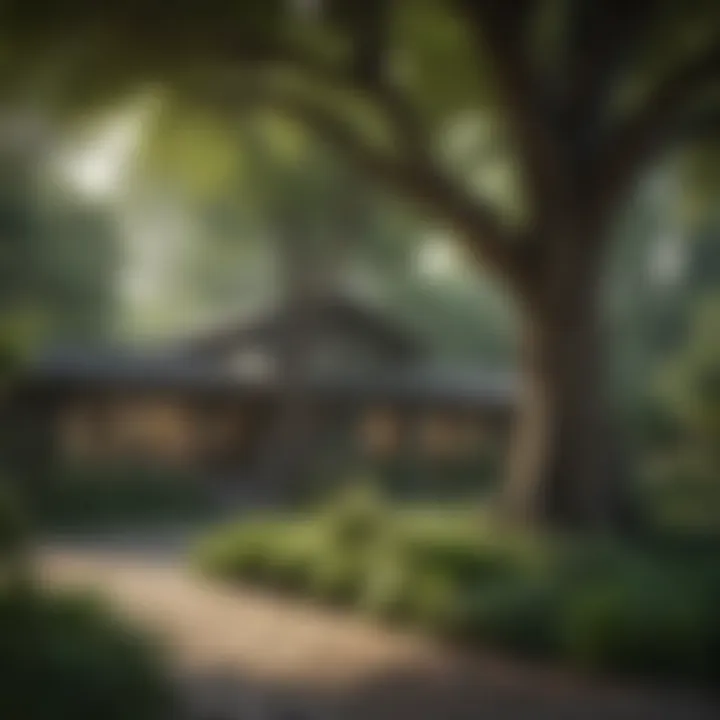Selecting the Best Trees for Your Home Landscape


Intro
Planting trees near your home can significantly impact both your living environment and the aesthetics of your property. Trees provide shade, enhance curb appeal, and promote biodiversity. However, selecting appropriate species for planting requires careful consideration of various factors to ensure they do not interfere with your home's structural integrity and landscape design.
Design Inspirations
Designing your landscaping with trees can create a harmonious balance between nature and architecture. Consider the following aspects:
Trending Styles
Current trends focus on incorporating native species and drought-resistant trees. Native trees typically require less maintenance and adapt with local climate conditions. Examples include:
- Red Maple
- Eastern Redbud
- Sweetgum
Additionally, adopting a naturalistic style by placing trees in a more organic layout can enhance the overall look of your yard. Another trend is using vertical space, such as columnar trees that take up little ground area but provide visual appeal.
Color Palettes
Choosing the right color palette can accentuate your home's architecture. Consider seasonal changes and the color of the trees' leaves and flowers:
- Spring: Cherry Blossom with its pink flowers.
- Summer: Bright green leaves of the Linde tree.
- Fall: The vibrant colors of Sugar Maple.
- Winter: The stark, beautiful branches of a Birch tree.
Combining varieties that bloom at different times enhances your yard's visual interest throughout the year, creating an inviting atmosphere.
"The right tree can be an artwork, enhancing both your home and your mood."
Maintenance and Upkeep
Ineffective maintenance can hinder the benefits that trees provide. Understanding regular maintenance needs is essential.
Seasonal Maintenance Checklist
Establish a seasonal checklist to ensure your trees remain healthy:
- Spring: Prune dead branches and check for pests.
- Summer: Monitor watering needs, especially during drought periods.
- Fall: Clear fallen leaves and debris around the base.
- Winter: Inspect for damage from snow and ice.
Cleaning and Organization Tips
Keep your yard organized by designating areas for clippings and other materials. Utilize compost bins for organic waste. Regularly check your landscape for pests and diseases; early detection is crucial for prevention without chemicals.
By integrating these considerations into your tree-planting strategy, you cultivate an environment that is both beautiful and sustainable, enhancing your home and neighborhood.
Preamble
Selecting the right trees to plant near your home is more than just a decorative choice. It plays a crucial role in the overall aesthetics, energy efficiency, and environmental impact of your property. Trees can provide shade, improve air quality, and enhance the beauty of the landscape. However, when choosing the wrong type or placing them too close, it can lead to various problems, including structural risks and maintenance issues.
Understanding the diverse characteristics of tree species, their growth patterns, and maintenance requirements is vital. It helps homeowners make informed decisions that align with their goals for their outdoor spaces. Furthermore, trees play an important role in the ecosystem. This article will explore the multiple facets—spanning from aesthetic enhancements to environmental benefits—that inform prudent decisions regarding tree planting near residential properties.
Also, one must consider the neighborhood’s legal regulations, proximity to structures, and the behavior of tree roots that could unintentionally disrupt foundations or underground utilities.
In essence, this article serves as a guide for anyone looking to enrich their living spaces with the appropriate trees. Being intentional about tree selection near the home can lead to lasting positive impacts on gardens, homes, and community health. As you read on, you will gain insights into how to choose trees that will thrive and coexist harmoniously with the surrounding environment.
Identifying the Purpose of Planting Trees
Understanding the purpose of planting trees is fundamental for homeowners considering this endeavor. Each tree contributes uniquely to the environment and the property's overall appeal. Determining the objectives behind planting can significantly influence the choice of species, position, and care practices. The right trees not only elevate the aesthetic quality of a residence but also offer multiple functional benefits.
Enhancing Aesthetics
When selecting trees close to a house, aesthetics is often a primary motive. Trees add color, texture, and shape to landscapes. Landscaped areas with trees often appear more inviting and lively. They create focal points or define spaces within a yard. For example, flowering trees like Cherry Blossom or Magnolia can introduce seasonal beauty, captivating any onlooker during blooming periods. Homeowners should consider native species as they blend naturally with local surroundings, enhancing the property’s attractiveness without appearing out of place.
Improving Energy Efficiency
Energy efficiency is another crucial factor. Trees can significantly influence building temperatures, leading to energy savings. Strategically placed trees can provide shade during summer months, which helps reduce cooling costs. Specifically, deciduous trees such as Maple or Oak can block sunlight during hot months, but shed their leaves in winter, allowing warmth from the sun to reach the home. This natural temperature regulation supports a more sustainable lifestyle and minimizes reliance on heating and cooling systems.
Providing Privacy


Trees also serve as effective natural barriers for privacy. They can create a secluded oasis away from prying eyes, particularly in urban settings. Tall evergreen trees like Leyland Cypress or Arborvitae are popular choices for this purpose. They provide year-round coverage, creating a sense of enclosure without compromising airflow. Thoughtful species selection can enhance solitude, reduce noise pollution, and foster a tranquil environment.
In summary, identifying the purpose behind planting trees guides homeowners in making informed choices. Focusing on aesthetics, energy efficiency, and privacy creates a well-rounded planting strategy. By doing so, one can ensure that the added flora will enhance their property in a thoughtful and harmonious way.
Environmental Considerations
Understanding environmental considerations is crucial when selecting trees to plant close to residential properties. Trees are not just decorative elements in the landscape; they serve multiple ecological functions that can significantly impact the environment and the homeowner's living space. When homeowners take the time to assess these considerations, they can promote biodiversity, improve soil conditions, and shape microclimates that benefit their property and the surrounding ecosystem.
Influence on Local Wildlife
Trees play a vital role in supporting local wildlife. By providing habitats and food sources, the right species of trees can attract various birds, insects, and other animals. When selecting trees, one should think about the species native to the area, as native trees contribute significantly to local ecosystems.
For example, oaks and maples can support numerous caterpillars that serve as food for birds. Planting trees that produce nuts, fruits, or nectar can also attract various wildlife, enhancing the beauty of your garden and creating a more vibrant environment. Protecting local fauna is not just beneficial for nature; it is also rewarding for homeowners who enjoy observing wildlife from their windows.
Soil Health and Stability
The root systems of trees can profoundly influence soil health and stability. A well-chosen tree can prevent erosion, especially on slopes or near water bodies. The roots help to anchor the soil, reducing runoff and promoting groundwater recharge. Furthermore, trees improve soil quality by cycling nutrients and promoting healthy microbial activity.
When considering trees for your landscape, it is vital to consider their root system behavior. Shallow-rooted trees might not provide the same stability as deep-rooted species, especially in areas prone to flooding. Therefore, assessing the soil type and condition will ensure that the selected trees will thrive and contribute positively to the ground's integrity.
Microclimate Effect
Trees significantly influence local microclimates. They can cool air temperatures in the summer, reduce wind speeds, and create shade—all of which contribute to a more comfortable living environment. For instance, large trees like the American sycamore can provide ample shade, decreasing the need for air conditioning.
When strategically placed, trees can block harsh winter winds, helping to maintain warmth in your home. This is not just an environmental consideration; it also has implications for energy savings. As a result, homeowners should assess how the placement and selection of trees can enhance or modify their immediate microclimate, providing additional comfort and potentially lowering energy costs.
"Creating a balance with nature can improve both the ecological environment and personal living spaces."
In summary, environmental considerations are fundamental in the process of selecting trees to plant close to your home. Making informed choices about species can enhance local wildlife habitats, promote soil health, and influence the local climate, contributing to a more sustainable and enjoyable living environment.
Tree Characteristics to Consider
When selecting trees to plant near your home, it is essential to understand their characteristics. The right choice can significantly enhance the beauty of your property and support the local environment. Trees can serve various purposes, from shade providers to aesthetic focal points. Knowing the traits of different species enables homeowners to align their choices with their landscape goals. This section delves into vital tree characteristics that influence both the functionality and the appeal of trees in residential settings.
Growth Habit and Size
Different tree species exhibit distinct growth habits and sizes. These factors directly affect how a tree will look as it matures. Some trees have a tall, narrow form, while others may spread wide. Consideration of growth habit is critical when planting close to the house. For instance, a large oak tree may provide generous shade but could pose risks if planted too near structures. On the other hand, small ornamental trees like Japanese maples can add beauty without overwhelming space.
Homeowners should assess not only their available space but also how tree size will impact their home over time. Trees like the Redbud can grow to a moderate height and provide vibrant spring blooms, while species such as the Silver Maple can reach substantial heights, leading to potential interference with rooflines or gutters. Careful planning can help homeowners avoid trees that may become problematic in the long run.
Root System Behavior
Understanding the root systems of trees is another vital factor to consider. Trees can have different types of root systems, such as shallow, fibrous roots or deep taproots. Shallow roots may spread extensively, potentially causing sidewalk heaves and foundational problems if planted too close to the house. Conversely, deep roots often grow straight down and can be a better choice for urban settings.
Certain species like the Pine may have a fibrous root system that spreads widely but remains relatively shallow. This makes them less likely to impact the home structure adversely. On the contrary, trees like the Magnolia might develop deeper roots that are anchored well but could still create complications if planted too close to the foundation. It's critical to pair the potentially invasive nature of the root system with the location of underground utilities and drains as well.
Ecosystem Compatibility
Not all trees thrive equally in various ecological settings. Selecting trees that are compatible with local ecosystems enhances not only the visual landscape but the health of the environment as well. Introducing species that are native to the area can bring myriad benefits, including improved biodiversity and support for local wildlife.
Native trees often have lower maintenance needs and are more resistant to pests and diseases. For example, Planting Prunus serotina, or Black Cherry, can offer beautiful blossoms and support bird populations. Non-native trees, while appealing, may not always adapt as well or may require additional care. Moreover, introducing a mix of species can foster greater resilience and health within the ecosystem. A careful review of local flora is necessary for choosing trees that will flourish and contribute positively to both home life and the wider environment.
Understanding tree characteristics is key to sustainable landscaping.
By evaluating growth habits, root systems, and ecosystem compatibility, homeowners can make informed planting decisions. Such choices will promote a sustainable and beautiful living environment.
Legal Considerations for Planting Trees
When considering planting trees close to your house, engaging with the legal landscape is essential. It is not simply about choosing the right species or determining aesthetic appeal. Legal considerations can save homeowners from future headaches. Understanding laws and regulations can provide protection and also enhance neighborly relations.
Understanding Local Ordinances


Local ordinances can vary significantly between regions. These rules often govern where and how homeowners can plant trees. For example, some municipalities have specific setbacks that dictate the distance trees must be planted from property lines or structures. Ignoring these ordinances can lead to fines or even the mandatory removal of the trees.
Homeowners should research and familiarize themselves with their local laws. Checking with local government websites or offices can provide necessary information. These laws are often available online. They outline restrictions or requirements that could influence tree planting decisions. Finding out if there are species restrictions can also be useful, as some regions try to prevent the planting of invasive or non-native species.
Homeowner Association Regulations
In addition to local ordinances, many communities are governed by homeowner associations (HOAs). These organizations may have their own set of rules for landscaping, including tree planting. Some HOAs might approve specific types of trees, while others may impose strict guidelines about height, spread, or even the color of the foliage.
It's critical for homeowners to review their HOA's governing documents. These documents often provide detailed information on landscaping requirements. Ignoring these guidelines might not only lead to disputes with neighbors but can also result in fines or mandates to change the landscape according to HOA specs.
Proactive engagement with both local ordinances and HOA regulations fosters community harmony while enabling homeowners to enhance their property effectively.
Being informed regarding these legal considerations ensures that tree planting is not only enjoyable but compliant. Therefore, homeowners are encouraged to take these steps seriously and seek clarity on these matters before making decisions.
Species Selection
Selecting the right species of trees is a fundamental aspect when considering what to plant close to your house. It is not merely about aesthetics or preference; it involves understanding the environmental and structural implications of each species. Different trees have varying growth patterns, root behaviors, and compatibility with local ecosystems.
By carefully choosing the tree species, homeowners can not only enhance their living space but also ensure the long-term health of their property. This selection process should take into account factors such as the size of the tree at maturity, the climatic conditions of the area, and the specific requirements of the homeowner.
This section details the benefits and considerations relevant to three main categories of trees: small, medium, and large. Each category has its own characteristics that make it suitable for different spaces and needs.
Small Trees for Limited Spaces
Small trees are ideal for properties with limited space. They typically reach a height of about 10 to 25 feet and have a compact growth habit. Choosing small trees can be particularly beneficial in urban settings where available space is at a premium.
Small tree varieties such as Japanese Maple or Redbud provide significant aesthetic value without overwhelming an area. They often have beautiful flowers or foliage that can enhance a landscape's charm. Moreover, they require less maintenance than larger species, making them easier to care for.
Considerations when planting small trees include their proximity to homes and how their roots may affect nearby foundations. Proper placement ensures that the tree's growth will not interfere with structures.
Medium Trees for Balanced Growth
Medium trees offer a balance between size and utility. They can grow between 25 to 50 feet tall, providing sufficient coverage and shade while still being manageable in terms of space. Trees like Flowering Dogwood and Hawthorn fit well into this category.
These species have the ability to provide substantial environmental benefits. They can support local wildlife, improve air quality, and reduce energy costs through shade. Medium trees can act as a focal point in residential landscapes, contributing both to beauty and functionality.
Nevertheless, it is crucial to consider their root systems. Ensuring they are planted at a sufficient distance from structures will prevent potential damage over time.
Large Trees for Shade and Canopy
Large trees, typically defined as those reaching heights over 50 feet, have a strong presence in a landscape. Species such as Oak and Maple are excellent for creating expansive shade areas. They offer numerous benefits, including reducing heat in summer and providing habitat for various wildlife.
The shade provided by large trees can significantly decrease energy costs by keeping homes cooler in the warm months. However, they require ample space both above and below ground, making them less suitable for smaller yards.
When considering large trees, it’s essential to evaluate the growth rate and lifespan of the tree. Some may grow rapidly but have short lifespans, while others grow slowly but provide long-term benefits. An informed decision ensures that the tree will thrive and add value for years to come.
Maintenance Requirements
Maintaining trees planted close to residential structures requires attention and care. This aspect is vital for several reasons: it influences tree health, preserves property safety, and enhances aesthetics. Homeowners should prioritize ongoing maintenance to ensure that their trees thrive and remain manageable.
Pruning and Trimming
Pruning is a critical practice for tree maintenance. Regular pruning promotes healthy growth, helping the tree develop a strong structure. It also removes dead or diseased branches, which can prevent further health issues. When branches grow too close to the house, they can also cause damage to the roof or siding. Trimming helps maintain an appropriate size and shape for the tree, ensuring it does not obstruct views or sunlight. Here are key considerations about pruning:
- Timing: The best time to prune most trees is during their dormant season, typically late winter or early spring. This minimizes the stress on the tree.
- Technique: Proper techniques should be followed to prevent injury to the tree. Improper cuts can lead to disease or undesirable growth patterns.
Watering Needs
Watering is essential for tree health, particularly in the early years after planting. Newly planted trees are establishing their root systems, which requires consistent moisture. However, it is important to strike a balance. Overwatering can lead to root rot, while underwatering can stress the tree. Factors to consider include:
- Soil Type: Sandy soils drain quickly but may require more frequent watering. Clay soils retain moisture longer, so they need less frequent watering.
- Tree Species: Different species have varying moisture needs. For instance, native trees often require less watering compared to exotic species adapted to different environments.


Pest and Disease Management
Managing pests and diseases is an integral part of tree maintenance. Trees can be susceptible to various issues that threaten their health and aesthetics. Proactive measures can help minimize these risks. Homeowners should consider:
- Regular Inspections: Checking for signs of pests or diseases is key. Early detection allows for prompt action before it escalates.
- Integrated Pest Management: This approach combines biological, cultural, and chemical practices to manage pests while minimizing harm to the environment.
- Species Selection: Some species are more resistant to common pests and diseases. Researching and selecting disease-resistant types can lead to less maintenance and healthier trees.
"Healthy trees provide benefits beyond beauty; they enhance air quality and support local ecosystems."
Overall, focusing on maintenance requirements ensures that trees remain a valuable asset to residential properties. Regular care not only promotes health and longevity but also enhances the beauty of the home landscape.
Potential Risks of Planting Trees Close to Houses
Planting trees near residential structures offers various benefits, but it is essential to be aware of the potential risks involved. Homeowners often focus on aesthetics and environmental impact, neglecting the dangers that can arise from improper placement of trees. This section highlights structural damage and allergen-related issues that may occur, providing homeowners with the necessary information to make informed planting decisions.
Structural Damage
One of the primary concerns when planting trees close to houses is structural damage. Tree roots can extend beyond the trunk and have a direct impact on foundations, driveways, and sidewalks. Massive roots may cause lifting or cracking in concrete surfaces, leading to costly repairs. In some cases, trees with aggressive root systems even compromise the structural integrity of the building itself, which could lead to significant expenses in foundation repair or remediation.
The size and growth habit of the tree are crucial considerations. Species like Silver Maple and Willow are known for their expansive root systems. On the other hand, small trees such as Japanese Maple tend to have less invasive roots. When planning a planting area, it is vital to assess the distance between the chosen tree and the house. Standard recommendation is to plant trees at least 15 to 20 feet away from the structure, depending on the species.
Remember: It is always easier to prevent damage than to repair it. Choose species with less aggressive root systems when planting near structures.
Allergens and Debris
Another important aspect to consider is the potential for allergens and debris. Many trees, such as Birch and Oak, release pollen during certain seasons. This can trigger allergic reactions in sensitive individuals. Additionally, trees often shed leaves, flowers, and seeds, which can create additional maintenance challenges for homeowners. This debris can clog gutters, create mud around the base of the tree, and require increased cleaning efforts around the property.
Selecting trees that have lower allergenic properties might be beneficial, especially for families with allergies. Cedar trees, for example, are often less allergenic compared to Pine or Cottonwood. Homeowners should consider both the seasonal beauty that trees can provide and their potential drawbacks regarding allergens and organic debris when making planting decisions.
In summation, the risks associated with planting trees close to houses can be substantial if not considered carefully. Being proactive about potential structural damage and allergen issues ensures a more pleasant and sustainable use of trees as a living asset around your home.
Choosing the Right Location
Selecting the appropriate location for planting trees near your house is a critical aspect of tree selection. The decisions made about placement can significantly influence the overall health of the trees, their immediate surroundings, and ultimately your home. Failing to consider location may lead to various complications, such as obstructed views, interference with structures, and potential damage to property. Therefore, a careful assessment of sun exposure, proximity to structures, and underground infrastructure becomes essential to ensure positive outcomes.
Sunlight Exposure
Sunlight is an essential element that affects the growth and vitality of trees. Each species has its specific light requirements, which can range from full sun to partial shade. When choosing the right spot for planting, it is crucial to observe how sunlight interacts within your yard throughout the day.
- Full Sun Trees: These trees thrive in areas that receive at least six hours of direct sunlight daily. Some examples include the Red Maple and the Eastern Redbud.
- Partial Shade Trees: These species can tolerate less light and are well-suited to areas that receive dappled sunlight or fewer hours of direct exposure. The Flowering Dogwood is a common choice for such locations.
Understanding the light needs of different species will help homeowners ensure that their trees grow healthily and do not become leggy or underdeveloped.
Proximity to Structures
The distance from structures is another important consideration when selecting a planting location for trees. Trees may grow large over time and cause damage to homes, driveways, or fences. Homeowners should assess current structures and consider future growth. Here are some important aspects to examine:
- Distance from the Foundation: Trees should be planted at least three to five feet away from the foundation of your house to prevent root interference and moisture buildup, which may lead to structural problems.
- Height Considerations: Tall trees should not be planted directly next to homes, as their branches can extend over the roof, depositing debris and impacting roofing material.
- Shade and Wind Effects: Trees can also influence the amount of sunlight your house receives, altering the energy efficiency of the home. It may reduce heating costs in winter but inhibit cooling in summer if not suitably placed.
Underground Infrastructure Awareness
Awareness of underground infrastructure is crucial before planting trees. Roots can disrupt utility lines or drainage systems, leading to costly repairs and unwanted inconveniences. Homeowners should take the following steps before planting:
- Identify Existing Utilities: It is vital to locate water, gas, and electric lines before planting any trees. Most utility companies can assist in this regard.
- Depth of Roots: Certain trees have invasive root systems that can penetrate deeply or spread wide. Choosing species with less aggressive roots, like the Japanese Maple, can mitigate risks to underground infrastructure.
- Soil Composition: The soil quality may vary with buried structures nearby. Ensure compatibility between the chosen tree species and soil composition to avoid poor growth.
Important Note: Always consult a local arborist or extension service for guidance on the best practices for planting trees near your home. Their expertise can help ensure successful tree selection and placement.
Culmination
In summary, selecting trees to plant near your house is not simply about aesthetics. It encompasses a range of considerations from environmental impacts to maintenance demands. Choosing the right species can enhance the beauty of your property, improve energy efficiency, and even create a sense of privacy. Yet, the decision should also take into account individual tree characteristics, such as growth habits and root systems.
Benefits of Thoughtful Tree Selection:
- Aesthetic Appeal: Well-chosen trees can elevate the visual appeal of a home, adding charm and character.
- Energy Efficiency: Proper placement can improve energy efficiency by reducing cooling costs in summer and providing windbreaks in winter.
- Environmental Benefits: Trees contribute to local wildlife habitats, help to mitigate soil erosion, and can create a healthier microclimate.
Considerations and Precautions:
- Understand the potential for structural damage due to large roots or overhanging branches.
- Stay aware of allergens and fallen debris that may occur from flowering or fruiting trees.
- Familiarize yourself with local planting regulations and community standards.
By following the guidelines outlined in this article, homeowners can make informed decisions that not only beautify their surroundings but also promote a sustainable living environment. In the end, the act of planting trees should be viewed as an investment in the future—one that provides benefits for both the present and generations to come.
"Choosing trees for your property is a thoughtful process that shapes both your home and community."







